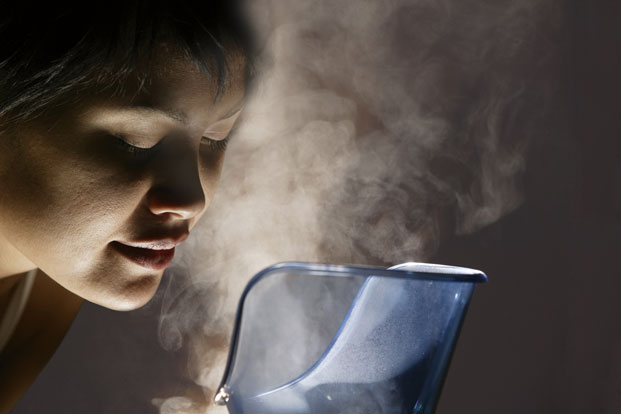Sinusitis, or sinus infections, is a major health problem. Each year, more than 31 million Americans suffer from the headaches, facial pressure and nasal congestion that are the hallmarks of these infections. More than $1 billion are spent annually on over-the-counter (OTC) medications to treat the symptoms of sinus infections, as well as $150 million on prescription drugs, and they are responsible for 16 million doctor visits. People who suffer from allergies, asthma, structural blockages, or people with compromised or weakened immune systems are at greater risk for developing sinusitis, but this condition may strike anyone, young or old, male or female.
Severe infections may require antibiotics. On rare occasions, infections of the sinus cavity can spread to the brain and become life-threatening, so serious care should be taken when making a home diagnosis, and if your sinus infection feels particularly fierce or is accompanied by symptoms like fever, you should call your doctor to get medical attention.
For those of us who have battled sinus infections, the pain and discomfort that they cause is all too familiar. This condition, which occurs when the cavities around your nose become swollen and inflamed, is typically caused by a virus and can linger long after other upper respiratory symptoms have eased. In rare cases, fungal or bacterial infections can cause a sinus infection, or it can be triggered by allergies, nasal polyps, tooth infections and deviated septums.
Because sinusitis is not always triggered by an infection, there are many popular home remedies for easing and preventing sinus symptoms. Here are seven ways that you can manage your sinus problems:
Humidifiers
Particularly dry air, which is common in colder climates in winter, can thicken mucus, clog the nose and irritate sinuses. Experts agree that adding humidity to the air with a humidifier is good for sinus health. Forced heating systems in homes or workplaces can often dry out the nasal passages, which are supposed to provide humidity and warmth and clean the air that passes through it. This dry air can keep nasal passages moister and help fight against allergies and sinus symptoms.
Air Purifiers
It’s often not enough just to have increased humidity in the air we breathe. When your sinusitis is triggered by environmental factors, including dust, smoke, mold and other irritants, an air purifier can add a second line of defense for the nose, filtering out these sinusitis triggers from our indoor air. While many acute sinus infections are triggered by viral or bacterial infections, Mayo Clinic research suggests that as many as 96 percent of chronic sinusitis sufferers experience immune responses to inhaled fungal organisms, such as mold that may grow in the home. An air purifier can help minimize the mold and fungi spores in the air you’re breathing.
Saline Nasal Spray
Not to be confused with medicated nasal spray, saline nasal spray can offer powerful relief from sinus symptoms. A saline mist spray works much like a portable humidifier, adding humidity directly to your nasal passages. This saline spray helps thin out and keep sinus mucus moving, helping to wash away allergens and germs before they cause inflammation or easing inflammation. Unlike decongestants, there is no danger of addiction to saline sprays, and they can be used safely up to six times per day.
Medicated nasal sprays may be a good short-term solution to ease sinus pain and congestion, but buyer beware: if you use these sprays for more than three or four days in a row, the body can start to require larger doses, more often, in order to continue offering relief. You can actually have more congestion when you try to wean yourself off the sprays as your body goes through withdrawal. Prescription alternatives, such as steroid nasal sprays (Flonase) can reduce inflammation without the same withdrawal symptoms as over-the-counter sprays.
Aromatherapy
Inhaling herbs or essential oil products, including rosemary, eucalyptus and peppermint may help relieve some of the symptoms of sinus congestion and may have antibacterial properties. Studies have suggested that a 2 percent dilution of eucalyptus oil kills 70 percent of airborne staphylococcus bacteria. In fact, commercial congestion rubs, like Vicks, still rely on derivatives from essential oils — such as thymol from thyme and menthol from mint in a petroleum oil base to ease congestion symptoms. In addition to chest rubs, you can try filling a steaming hot sink and adding a few drops of essential oils, then leaning over the sink with a towel draped over your head to breathe in the benefits.
Neti Pots
A neti pot, which looks like a small teapot, is like a saline sinus bath. This container is designed to rinse debris and mucus from your nasal cavity by pouring a saline solution into one nostril, so that it drains out through the other nostril. In addition to having the force to flush out irritants that may aggravate your symptoms, neti pots help by adding moisture to your nasal passages.
Nasal Irrigation Systems
A nasal irrigation system is really a more sophisticated version of the neti pot. This system works by combining humidifying and rinsing actions, with an added benefit of a pulsing feature that aims to rid the nasal passages of irritants and thick mucus more efficiently. While these systems are pricier than nasal sprays and neti pots, they may be beneficial to chronic sinusitis sufferers or for people who suffer from seasonal allergies.
Steam Therapy
Steam therapy is an effective treatment for nasal congestion. Breathing in the steam from a hot bowl of chicken soup or cup of tea can ease sinus symptoms, while ingesting these foods and beverages can help battle the underlying infections causing them. Taking a hot shower may be enough to offer relief from sinus congestion, and you may want to invest in shower tablets that will add the benefit of aromatherapy. If you need more than a hot shower, there are products for sale that are specifically designed to provide steam therapy.

Leave a Reply